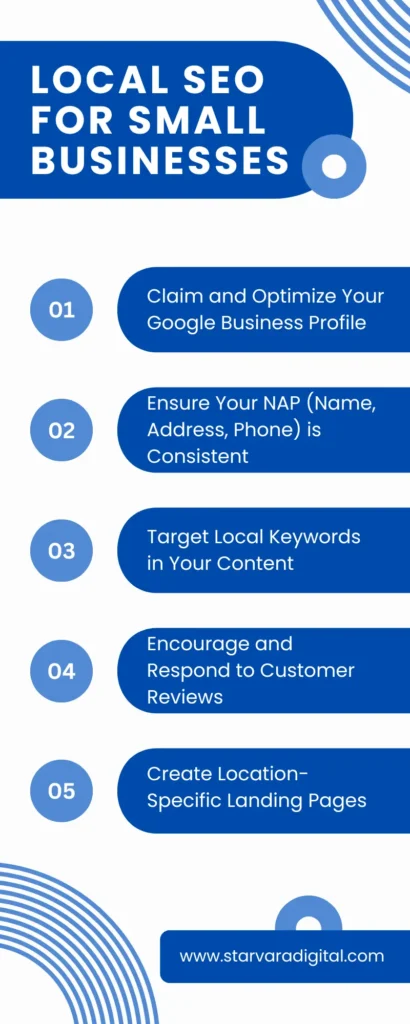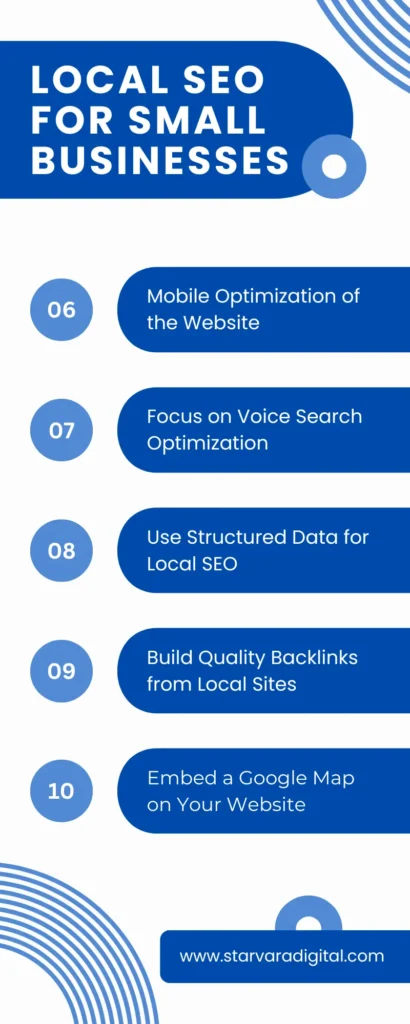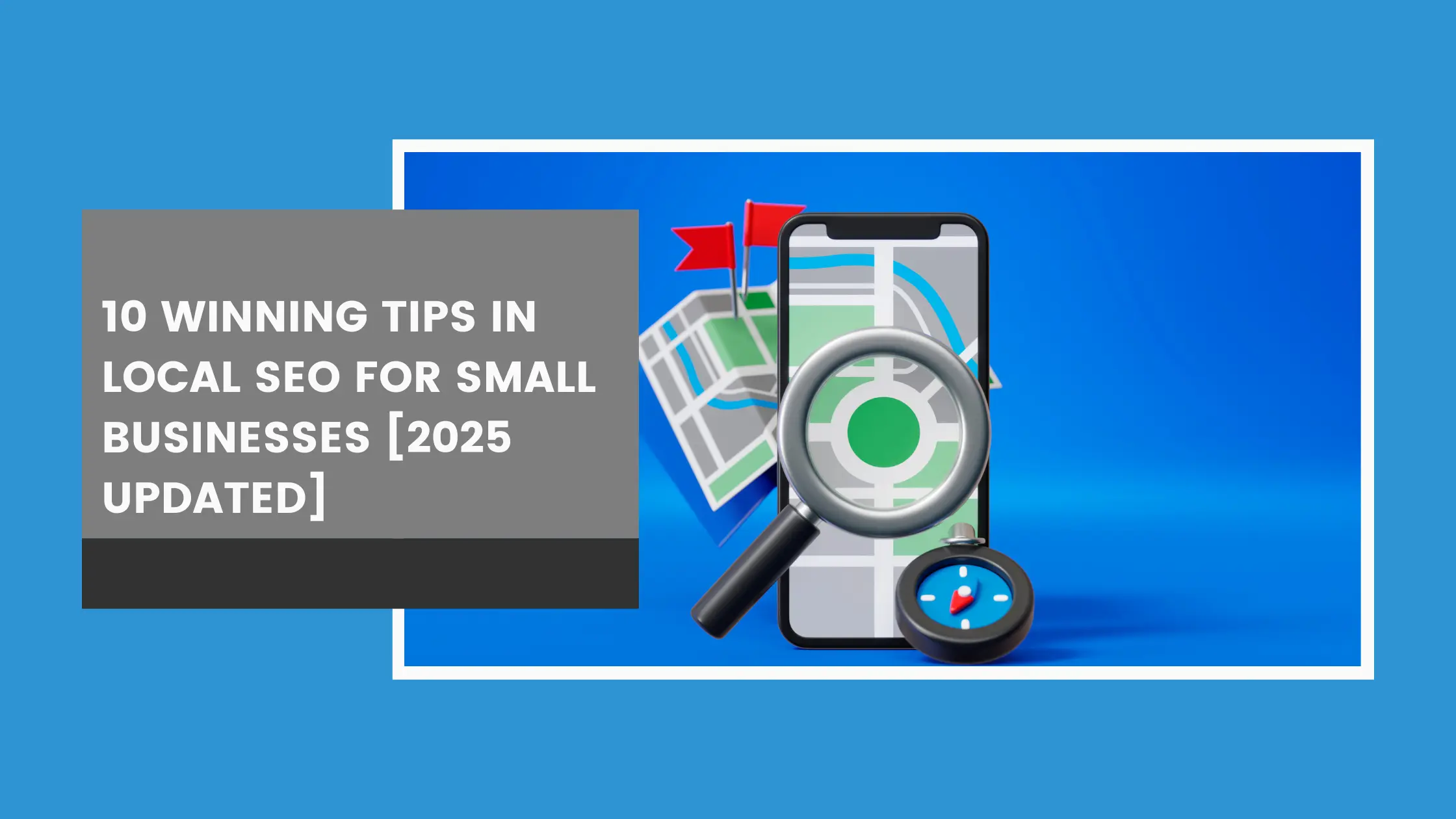If you own a business and want to attract all your local customers, this blog has 10 proven local SEO optimization strategies to win in 2025. Let’s start.
1. Claim and Optimize Your Google Business Profile
Let’s start with a bitter truth—if your small business isn’t on Google, do you even exist? 😅
First things first: claim your Google Business Profile (GBP). Head to Google Business Profile. Sign up if you haven’t already.
Now, let’s talk about GBP optimization.
Your GBP is the key to luring your local customers. If you were running a coffee shop and someone searched “Best coffee near me,” wouldn’t it be great if you showed up on top of Google results? So, how do we optimize your profile to make this happen?
Add every little detail:
- Your business name, address, phone number (NAP—more on that next!), website link, and even your working hours.

Upload some drool-worthy photos
- Yes, people do judge a place by its pictures. Whether it’s the positive vibes of your workspace or your smiling team, visuals matter. Post them all!
Use keywords in your business description:
- For example, “Family-owned coffee shop in [City Name] serving organic, fair-trade coffee since 2010.”
Update your profile regularly
- Offer discounts? Running an event? Don’t forget to add it here!
Note: Let the messaging option be turned on in your profile. It will help your prospects ask quick questions easily. Engagement too matters in local SEO for small businesses.
2. Ensure Your NAP (Name, Address, Phone) is Consistent
Shall we play a quick game now?
Search for your business online.
Do your name, address, and phone number match everywhere?
If not, we’ve got a problem, my dear friend.
Wait, did your business not even show up?
Well, that’s a whole lot of serious problems (create your GMB profile with us today!).
Imagine a customer who is in dire need of your service. He finds your place on Google, and drives to your location, only to realize it’s the wrong address!
How frustrating could that be for your customer? Please don’t ever let that happen because they might even leave by submitting negative reviews and mentally your brand would have imprinted a very bad reputation. Good luck convincing them again!
So, use the following checklist in your local SEO strategy to avoid such scenarios.
✅ Start with your website—verify that your Name, Address, and Phone (NAP) details are 100% accurate.
✅ Review every online directory where your business is listed, including:
- Yelp
- JustDial
- TripAdvisor
- Niche platforms relevant to your industry
✅ Use tools like Moz Local or BrightLocal to audit and ensure consistency across all platforms.
Secret hack: Google loves consistency. If your NAP is unanimous across the internet, Google can reward you with a little ranking boost.

3. Target Local Keywords in Your Content
Now comes the magical part – local keywords. Without them, there’s no local SEO strategy!
Prospects who want to get a haircut won’t just search for “hair salon”, instead they’re typing ‘the cheapest hair salon in Chennai.” That’s your cue!
- Use tools like Google’s Keyword Planner or Ubersuggest to find such local search terms.
- Sprinkle these keywords naturally across your website: in your service pages, blog posts, and even your meta descriptions.
For example, if you own a bakery in Bangalore, don’t just say “We bake fresh bread daily.” Try, “We’re Bangalore’s go-to and affordable bakery for fresh cakes and sweet treats.”
Secret hack: Write a blog post about something hyper-local. Something like, “5 Best Desserts to Try in Bangalore” featuring your goodies. This will help you in two ways:
i) SEO results.
ii) Gets you involved in local conversations.
4. Encourage and Respond to Customer Reviews
What do people trust more than advertisements?
REVIEWS!
Yes, even if they’re from strangers.
48% of consumers say that user-created honest reviews by named individuals give them a good impression of their business.
Here’s how to encourage reviews without sounding desperate:
- Simply ask! After a customer has a great experience, say, “Hey, if you loved our service, would you mind leaving a review on Google?”
- Make it easy. Add a QR code at your checkout counter that links directly to your review page.
But don’t stop there.
Responding to reviews—whether they’re glowing or grumpy—is equally important.
Got a five-star review? Reply with, “Thank you! We loved having you. Can’t wait to see you again!”
And for those dreaded one-star reviews, don’t lose your calm. Respond politely and offer a solution. Something like, “We’re sorry to hear this! Please email us at [Your Email] so we can make it right.”
5. Create Location-Specific Landing Pages
Here’s a fun scenario: If you were running a chain of yoga studios across three different cities, would it make sense to have just one generic webpage for all of them?
Uhh, nope.
This is where location-specific landing pages can be of good help!
Create a unique page for each location. For example:
- [YourBusinessName].com/chennai
- [YourBusinessName].com/new-york
Each page should include:
- Address and contact info for that specific location.
- Unique photos (don’t reuse the same ones! your customers can easily spot them).
- Reviews or testimonials from local customers.
- A little description personalized with a major highlight from that area: “Our Chennai studio is located in the vibrant heart of the city, just minutes away from Marina Beach.”
This is one of the easiest local SEO optimization techniques. By doing this, you’re making it easier for your customers and telling Google, “Hey, I’m relevant in this city.” Win-win!
6. Can Mobile Optimization Help With Local SEO?
Do you remember the last time you searched for something on your desktop?
Can’t remember? Same here!
Most people today use their smartphones for everything—from finding nearby coffee shops to booking appointments. If your website isn’t mobile-friendly, you’re outright leaving money on the table.
If a potential customer lands on your site but the site takes forever to load, and if they couldn’t get what they wanted, they’d jump off immediately. Don’t be that business that gives away customers for free.
Here’s what you can do:
Switch to a responsive design
- From a 6-inch phone to a 13-inch laptop, make your site adapt to screens of all sizes.
Speed matters:
- Tools like Google’s PageSpeed Insights can help you identify what’s slowing your site down
Check your buttons:
- Check if the buttons are easy to spot and tap. Accidentally clicking on a button that takes your customers to an unintended page would be the last thing they want.
Test it yourself:
- Finally, visit your website on your phone and ask, “Would I stay on this site or hit the back button?”

7. Focus on Voice Search Optimization
“Hey Alexa, where’s the best pizza near me?”
Sound familiar? Voice search is getting bigger in 2025.
But how to make your business show up when someone asks Siri or Alexa?
Start thinking conversational. People using voice search don’t type “pizza Chennai.” They ask, “Where can I get the best pizza in Chennai?”
Here’s how to get ahead:
Focus on long-tail keywords:
- Instead of “best pizza,” target phrases like “Where can I get the best wood-fired pizza in Chennai?”
Answer FAQs on your site:
- Create a section with common questions customers might ask. For example, “What are your opening hours?” or “Do you offer vegan options?”
Be local-focused:
- Optimize for phrases like “near me” or specific neighborhoods.
Use natural language:
- Your content should sound like a friendly conversation, not a textbook.
8. Use Structured Data for Local SEO
Alright, now put on your tech hats as this is a geeky tip.
Structured data (also called schema markup) is like a secret language you use to tell search engines exactly what your website is about.
Let’s break it down: Imagine you’re running a bakery. You can use structured data to tell Google things like:
- Your business type (Bakery)
- Your address and opening hours
- Customer reviews and ratings
Why does this matter? Because when search engines are nothing but bots and structured data is one of the languages they easily understand. The better you help them understand your website, they’re more likely to feature you in rich results, like those star-studded listings or “near me” searches.
Here’s what to do:
- Use tools like Google’s Structured Data Markup Helper to generate the code.
- Add schema markup for things like your location, hours, menu (if you have one), and reviews.
- Test it using Google’s Rich Results Test to make sure everything’s working perfectly.
9. Build Quality Backlinks from Local Sites
Susan RoAne, an American author, once said, “It’s not what you know, it’s who you know.”
Makes sense, right?
Well, it does in the world of SEO too.
Oh, yes, we’re talking about backlinks. Backlinks are your “who you know.”
But here’s the catch: not all backlinks are created equal. A link from your cousin’s random blog won’t help much, but a link from a trusted local news site or popular local blog? Now we’re talking!
Here’s how to get those elite local backlinks:
Partner with local businesses:
Collaborate on events or promotions, and ask them to link to your site.
Reach out to local bloggers:
Invite them to try your service or product, and they might just write about you.
Sponsor community events:
Whether it’s a charity run or a school fundraiser, your sponsorship often comes with a link on their website.
Write guest posts:
Share your expertise on local blogs, and include a link back to your site.
10. Embed a Google Map on Your Website
The most basic tip of all, yet the most important one. If you don’t have a map embedded on your site, you are just making the lives of your prospects and customers hard and risk losing them.
Embedding one is super simple and makes life so much easier for your customers.
Here’s how to do it:
- Go to Google Maps and search for your business.
- Click the “Share” button and choose “Embed a map.”
- Copy the code and paste it into your website.
Bonus points if you add directions! For example, “We’re just a 5-minute walk from Marina Beach, right across from XYZ Café.”
Note: Adding a map signals to Google that your website is tied to a specific location. That’s a double win for local SEO!
Local SEO for Small Businesses – Starvara Digital Agency
If you’re a small business owner looking to optimize your website to rank for local rankings, reach out to Starvara Digital for our premium local SEO services. Over 6+ years, we’ve worked on 100+ projects and helped our clients generate inbound leads with SEO. Contact us and let’s get started.







